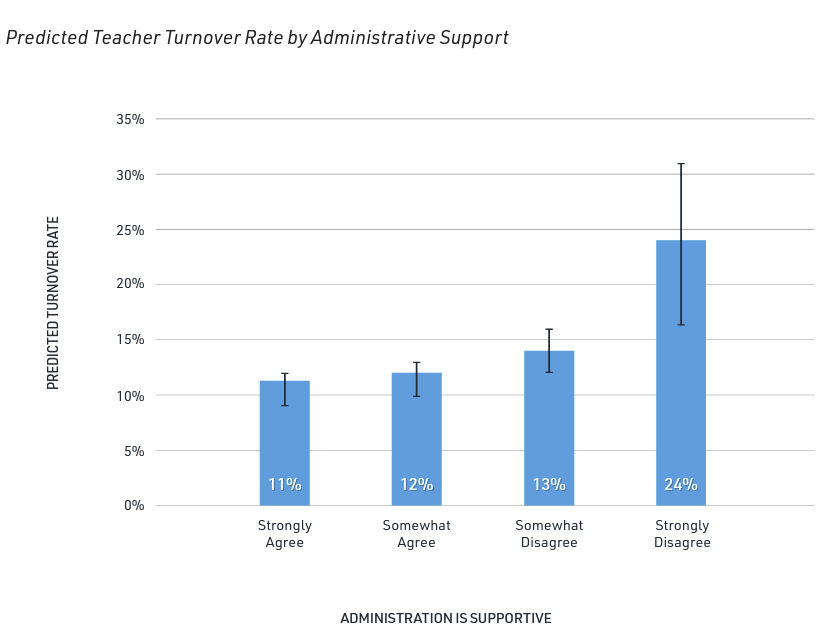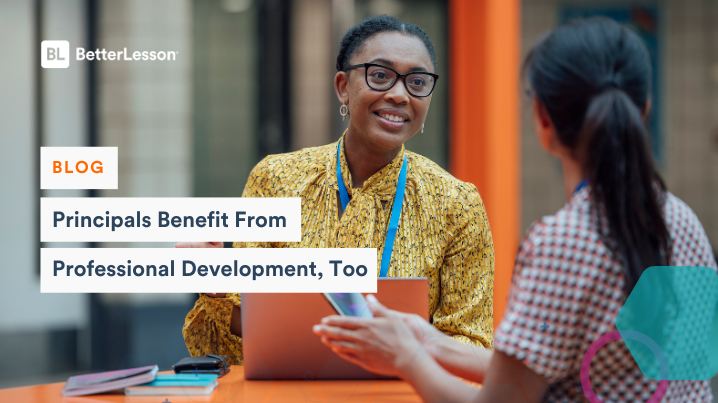Professional development is almost exclusively understood as the necessary and ongoing training and support for teachers and staff. However, this excludes a critical part of a school’s ecosystem who also need professional support: principals.
Principals, just like educators, can benefit immensely from learning new skills, deepening their practice, and participating in collaborative learning communities. Principals, just like educators, deserve access to ongoing learning opportunities.
When we broaden our understanding of professional development to include principals, we communicate a clear message: Everyone–from students to teachers to principals–have new skills, knowledge, and perspectives they can learn. This shift can be transformative, not only improving principals’ leadership practices, but establishing a learning environment and school culture that explicitly encourages lifelong learning.
It’s important to note, too, that principals want access to professional development. In fact, a research report published by the National Association of Secondary School Principals and the Learning Policy Institute asserts that principals cite a lack of professional learning opportunities as a top reason why they leave the profession.
In addition, there is deeply compelling research that demonstrates the impacts professional development for principals can have on principals’ leadership, teacher practice, and student outcomes. After exploring the broader impact of principals, let’s look at the research in each of those categories.
Impact of Principals
First and foremost, to understand the importance of PD for principals, it’s important to understand what the research says about how principals impact school culture and student learning. Dr. Brendan Bartanen, a researcher out of Texas A&M University explores the impacts principals have on schools, and the findings are telling of just how broad an impact they have.
Dr. Bartanen’s research concludes that principals play a critical role in reducing chronic absenteeism. His research also finds that poor leadership is a top driver of teacher turnover rates. Additionally, Dr. Bartanen’s research asserts that principals have an impact on student achievement, though the impact is often more indirect through their hiring, retention, and training processes. Principals also deeply impact a school’s culture and climate.
When we see what is at stake with a principal’s effectiveness–student attendance, teacher retention, academic achievement, and school culture–the necessity and urgency for principal PD becomes clear.
Principals’ Leadership Practices
For teachers, even aside from formal professional learning opportunities, there are plenty of informal opportunities for meaningful professional learning and collaboration through relationships with colleagues. However, principals don’t have the benefit of immediate access to peer-colleagues. It turns out, this absence is deeply felt among principals. Research published in Educational Management Administration & Leadership explored experienced principals’ experiences with professional learning opportunities.
Their findings “revealed how the principals who participated in the study highly valued the opportunities for professional learning and interactions with professional peers in the course they participated in. They perceived it as the most effective, beneficial, and relevant form of professional learning.” This demonstrates that principals have a distinct need for the collaborative learning that comes with professional learning opportunities. Ultimately, this study concludes with the following assertion: “Principals need access to systematized, formal professional learning at all stages of their careers, not just qualifying pre-service or in-service principal training.”
Along with the clear understanding that principals deserve and want access to PD, research shows that those professional learning opportunities can have meaningful impacts on their leadership practices.
The aforementioned report published by the National Association of Secondary School Principals (NASSP) and the Learning Policy Institute (LPI) also asserts that “Some research has found that professional learning opportunities for principals, such as high-quality preparation programs, ongoing training, peer networks, and coaching support, can build leadership capacity and reduce principal turnover.” The report goes on to explain that research suggests that PD programs for principals can improve principals’ self-efficacy.

Graph from page 8 in the report published by the National Association of Secondary School Principals (NASSP) and the Learning Policy Institute
Similarly, a report published by the Learning Policy Institute and the Wallace Foundation states that high-quality PD for principals is associated with “principals’ feelings of preparedness and their engagement in more effective practices to stronger teacher retention and improved student achievement.”
Research out of Texas A&M University offers even more connections between principal PD and improved leadership practice: “After receiving just 50 percent of the training, principals in the treatment group were reporting positive effects. Of note, principals receiving the training reported higher levels of knowledge and involvement in their school’s curriculum, instruction and assessment programs, higher levels of efficacy and a greater likelihood to create a positive school climate.”
The research is plain: Principals want and greatly benefit from access to learning opportunities.
Teacher Practice
The quality of a principal’s leadership can have significant impacts on teachers’ practice and classroom instruction.
Dr. David Grant, a researcher out of the University of Redlands, explores the connection between various principal leadership practices and teacher effectiveness and morale. In his study, he uses the term “community learning” to explain “principal practices that included such things as taking time to talk informally to students and teachers during recess and breaks, and creating professional growth opportunities for teachers.” His research found that “greater frequency of principals’ community learning practices was an important predictor of teacher engagement. Ineffective teachers experienced a lower frequency of community learning.” In other words, there is a clear association between the leadership quality of principals and the effectiveness of teachers. This has significant implications for how we think about investing in the leadership capacity of principals. In essence, providing meaningful PD for principals can have far-reaching impacts on teacher engagement and instruction.
Moreover, the joint NASSP & LPI report purports that “when principals leave, teachers’ views about their school and classroom conditions, as well as their curriculum and instruction, are less favorable.” From this, we can reasonably conclude that principals play a significant role in how teachers perceive critical factors like curriculum and instruction and that by investing in the effectiveness of principals, we can impact these important components of learning environments.
Student Outcomes
There are many factors that influence student outcomes, but a research report out of the Wallace Foundation explains the consequential role principals play in student achievement. Researchers synthesized the last two decades of studies on the relationship between school leadership and student achievement, and the results are staggering.
The report offers the following finding to illustrate the impact of principals on student learning: “We estimate that the impact of replacing a below-average elementary school principal (i.e., one at the 25th percentile of effectiveness) with an above-average principal (i.e., at the 75th percentile) would result in an additional 2.9 months of math learning and 2.7 months of reading learning each year for students in that school.” The report goes on to compare the impact of principals vs. teachers on student outcomes: “This comparison shows that the impact of having an effective principal on student achievement is nearly as large as the effect of having a similarly effective teacher.”

Graph from page 40 in the research report by the Wallace Foundation. SD = standard deviation
These findings communicate a clear message: Principals have serious impacts on student achievement.
Given this deep influence, the report concludes that “principals really matter. Indeed, it is difficult to envision an investment with a higher ceiling on its potential return than a successful effort to improve principal leadership.” In other words, when we invest in the professional development of principals, we are investing in the success of students.
Conclusion
With the robust research on the powerful impacts principals have in schools and the potential of professional learning opportunities to positively increase those impacts, it’s time to seriously explore how to invest in the leadership capacity of principals. This is critical not only for principals, but for teachers, students, and broader school communities.
BetterLesson has years of experience offering demonstratively meaningful professional learning opportunities for principals and school leaders. One of our partners, School Principal Jeff Cook from Wilson STEM Academy, spoke to the benefits of partnering with BetterLesson when he shared, “Having that thought partner who isn’t connected to the district gives me the freedom and confidence to explore ideas and be creative. And having someone who can package these ideas and follow up in a way to help with implementation is so important.”
BetterLesson offers executive coaching for principals and a wide range of learning opportunities–virtual workshops and on-demand, asynchronous–all designed specifically for principals and school leaders.
We know from research that investing in professional support for principals is ultimately an investment in the success of a school community.
Schedule a call with us today to learn more about how we can partner with your school or district to provide personalized, impactful professional learning opportunities for your principals and school leaders.
Get in Touch







